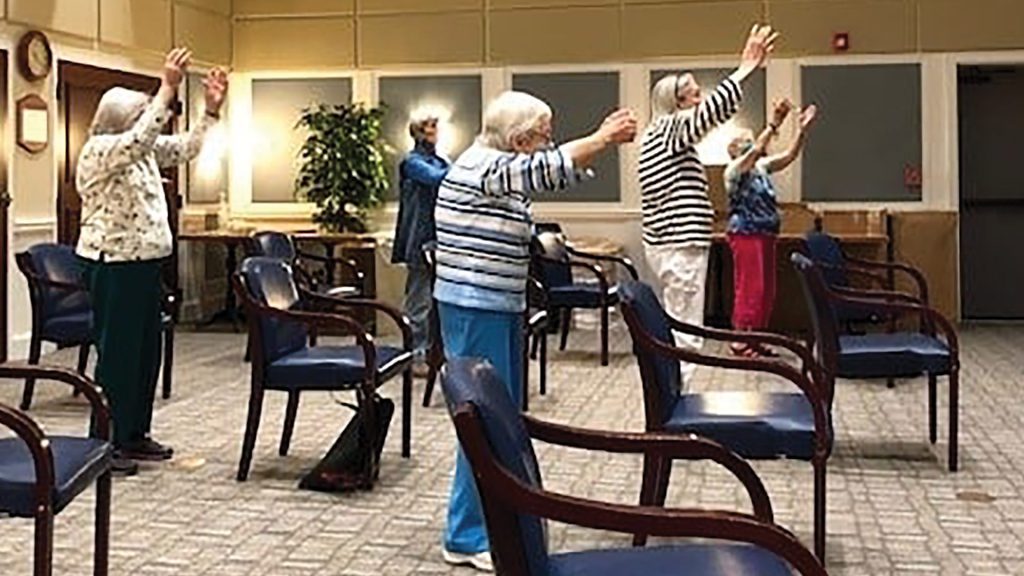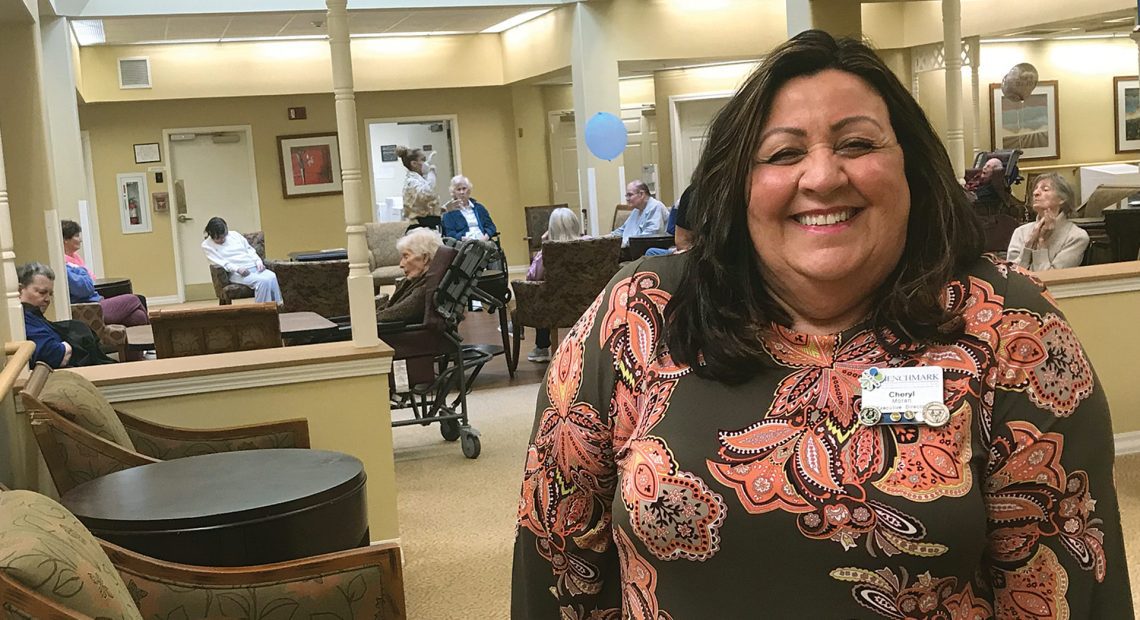‘We’re Like a Cruise Ship’
By Mark Morris

Cheryl Moran supervises a balloon volleyball game at the Atrium at Cardinal Drive.
Visit any senior-living community and it’s easy to notice all the activities residents take part in. But there’s more to all that activity than just fun and games.
Indeed, while providing entertainment, activities also contribute to the well-being of seniors in every setting, from independent living to assisted living and memory care, and even in skilled-nursing facilities.
It all begins with crafting an activities calendar. Sondra Jones, chief marketing officer for the Arbors Assisted Living communities in Amherst, Chicopee, Greenfield, and Westfield, said residents have a full schedule of activities from 9 a.m. to 7 p.m. They can take part in anything from exercise sessions to religious services to food classes and lectures. On one sunny day in October, residents in Chicopee took part in an outdoor drumming circle. Calendar offerings change all the time based on the types of activities that interest residents the most.
“Because people live here, we’re in essence an apartment building,” Jones said. “And in some ways, we’re like a cruise ship, because residents have all their meals and activities here, too.”
Even with nearly a dozen scheduled activities available each day, some residents might want to take part in something that’s not on the calendar. That’s OK with Cheryl Moran, executive director at the Atrium at Cardinal Drive in Agawam, who noted that this is their home and the staff are visitors in the home.
“The activities our residents take part in are all geared to keeping these skills a part of their everyday life. When they begin to struggle with a skill, we step in and help them find a different way to succeed.”
“One woman likes to spend her time doing crossword puzzles, and another just likes to paint because it makes her feel like an artist,” Moran said.
Heidi Cornwell, director of Marketing & Sales for Kimball Farms Life Care in Lenox, said most facilities make sure they cover five key areas when planning an activities calendar: gross motor skills, socialization, self-care, sensory, and memory. Specific activities are usually modified to fit a particular setting to help everyone keep moving and engaging as part of their daily routine.
“The activities our residents take part in are all geared to keeping these skills a part of their everyday life,” Cornwell said. “When they begin to struggle with a skill, we step in and help them find a different way to succeed. We work very hard to be a failure-free environment.”
According to Lori Todd, executive director for Loomis Lakeside at Reeds Landing in Springfield, when a person needs medical attention in a skilled-nursing setting, activities remain an essential factor in the patient’s recovery.
“Activities definitely help patients by encouraging the kind of wellness behaviors that contribute to the healing process,” she said.
Meanwhile, in settings such as assisted living, the level of functioning varies from person to person. Moran said she likes to have everyone together because it creates a dynamic in which people of different levels of function help each other with activities or just daily life.

Residents at the Arbors in Chicopee participate in an outdoor drumming circle.
“Our high-functioning residents enjoy helping people in wheelchairs or those who need help in some other way,” she told BusinessWest. “For the person who functions on a higher level, it gives them a sense of purpose.”
Much More Than Bingo
In the past, senior-living activities usually concentrated on gathering for bingo. While bingo remains popular, Todd said many group activities now aim to incorporate exercise so they can combine something fun with meeting a patient’s rehab needs at the same time.
“When setting up the calendar, we make sure to include plenty of wellness activities, whether they are emotional, physical, social, reminiscing, basically anything that helps memory or keeps people physically active,” Todd said. They also insert fun social activities such as a happy hour with an entertainer. “We strive for feel-good activities as well as ones that promote healing.”
Physical and social activities are certainly not limited to schedules on a calendar. Cornwell discussed how the actions of a resident leaving their apartment, walking down the hall, perhaps taking an elevator, and then walking to the dining area all contribute to physical activity. Once they arrive, they sit with a friend or neighbor and then engage in conversation, which adds to their social experience.
“When setting up the calendar, we make sure to include plenty of wellness activities, whether they are emotional, physical, social, reminiscing, basically anything that helps memory or keeps people physically active.”
“This is where senior living provides much more physical movement than if the person was at home,” she added, “where a caregiver brings them a meal and they might not leave their chair all day.”
Activities involving music are popular in every senior-living setting. While singers are not yet allowed in most places due to COVID-19 concerns, Cornwell said it’s a form of therapy when violinists, pianists, and other musicians come to play.
“Studies show music touches a part of the brain and leaves a positive impact,” she noted. “Music goes a long way toward self-care and helps people feel better about themselves.”
Jones credits her activities staff for finding an innovative way to include singers into music performances while still following COVID mandates.
“We had singers outside in the courtyard area while the residents gathered in the library with the doors open so they could see and hear the entertainment from a safe distance,” she said.
As mandates continue to gradually ease, everyone who spoke with BusinessWest expressed gratitude for all the difficult work the staff at senior-living communities performed during the worst days of the pandemic.
At the height of COVID, residents were essentially quarantined in their apartments, so staff at each facility made an extra effort to stay engaged with them.

Residents at Kimball Farms engage in tai chi.
“Our resident-care attendants and activity teams all turned into nail technicians, hairdressers, and personal stylists,” Cornwell said. “They did everything to keep residents looking good, feeling good, and feeling like someone cared.”
At the peak of the pandemic, when frequent temperature taking was essential, staff would dress up as a lion or some other whimsical costume just to get a laugh out of the residents.
One common practice at several facilities involved opening apartment doors and encouraging residents to socialize from the entrance of their unit. Staff would also use the hallway as the focal point for a bingo game and, in one instance, as a socially distanced bowling alley. “All the staff found creative ways to keep things social,” Jones said.
Added Cornwell, “the pandemic has been difficult and extremely challenging. Our residents rallied, and I give our staff 100% props for their out-of-the-box thinking to keep people safe and engaged.”
Before vaccines were available and while COVID was rampant, Todd said patients at the skilled-nursing facility at Loomis Lakeside at Reeds Landing could not have any visitors in their rooms. Fortunately, that unit is located on the first floor.
“Families were able to visit their loved ones through the window and could communicate by phone or iPad through the glass,” she explained. “We wanted to address social isolation while at the same time keeping everyone safe.”
Without that effort to engage with residents, the lack of socialization can quickly lead to depression, Jones noted. “Once they could leave their rooms again, I heard one woman say to another, ‘I haven’t held anyone’s hand in so long.’ Social interaction is a good distraction.”
For nearly four years, Gladys Fioravanti has lived at the Arbors in Chicopee. She believes activities are an important part of staying healthy.
“If you sit in your room day after day, you start thinking too much,” Fioravanti said. “You think of your loss, then you break down and cry and need some pills to calm you down, so I think it’s good to have something to do.”
She takes part in a number of activities because they keep her busy, but not too busy.
“I like the exercise class in the morning followed by the Mass right after,” she said. “After exercise, the Mass allows you to cool down.”
One afternoon, Fioravanti was sitting in the library area with several friends, including Claire Henault, whom Fioravanti met at the Arbors.
“We play cards together,” Fioravanti told BusinessWest. “We cheat together — I mean, Claire cheats.” At which point Henault chimed in, “I can’t be cheating because I never win.”
Moving Toward Normalcy
While residents are free to move around their facilities, families are not yet allowed in common areas but may visit loved ones in their apartments, where they can eat in the unit or take the resident out for dinner. Before COVID, families could join the loved ones during activity time.
“Recently, a family member called just to ask when they can attend the activities again because they enjoyed it too,” Moran said.
All the managers praised the patience families showed during the worst days of COVID. Since the beginning, Cornwell said, they have educated families on the latest protocols and good safety habits. “And we’re still educating them.”
The use of iPads and other tablets were a key to connecting families with their loved ones when no visitors were allowed. Cornwell said Kimball Farms parent Berkshire Healthcare Systems invested in tablets so residents could speak to family members on Skype or FaceTime. Even for residents who were aphasic and had trouble with verbal communication, that connection was still important for all involved.
“Even if the resident couldn’t verbally express their feelings, they could at least see the faces of their loved ones and hear their voices,” Cornwell explained. “Family members were able to see the resident’s smile and maybe even some blush on their face when our care attendants would put some makeup on them to help them look beautiful for the camera.”
As more people receive the COVID vaccine and booster shot, Moran hopes to eventually see families back inside the Atrium at Cardinal Drive.
“It’s enjoyable when we have lots of people here with the residents and the families are all talking with each other,” she said. “I don’t know when we’ll be able to invite everyone back in, but I hope we eventually can because I miss them.”
Like many industries, senior care is always looking to add more staff. Still, Jones noted, while the Arbors had some challenges, staffing is not a big issue.
“We have several staff members who have been with us for more than 20 years,” she said. “We will always have turnover, but we also have a core of stable employees, so that’s a real positive.”
During the height of COVID, Moran hired a number of Harbor Universal Associates (HUAs) to accommodate residents who may want coffee before 9 a.m. when breakfast is served. By having this extra staff person to help and engage with residents, Moran can offer what she called parallel programming.
“We may have one main activity going on in the center of the room, while several smaller groups are doing what they want around the perimeter,” she said. “The HUAs provide that added level of support for our residents who want to do their own thing.”
When a family comes to visit a new resident, Jones said, her goal is to be able to tell them, “your mom is busy right now.”
Ultimately, she added, all the activities available for seniors creates what she called a healthy distraction. “It beats having dinner with Pat and Vanna every night.”






